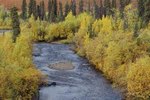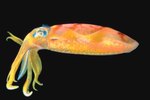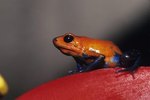
Northern krill are tiny crustaceans that float in large swarms. Found from the north Atlantic Ocean to the Mediterranean Sea, northern krill (Maganyctiphanes norvegica) and their larvae are staple food sources for many marine animals. Northern krill are bioluminescent, and their diet of copepods causes them to shine red. A large mass of northern krill can cause ocean water to appear pink from above.
Mating
Northern krill mate during spring and summer. They mate only when food is abundant. The male continuously produces sperm packets. Using his legs, he deposits them in the female's reproductive organs shortly after she molts. The eggs fertilize as they exit the female's body. She broadcasts the eggs, up to 10,000 at a time, into the water. The eggs float freely for about 10 days, before slowly sinking. Adult females spawn several times a season, usually about every other molt.
Hatching and Development
Northern krill go through four larval stages after hatching. There are several sub-stages to each larval stage, and the larvae shed their exoskeleton during each sub-stage. They become larger and grow more appendages with each molt. After hatching, larvae rely on yolk reserves for their nutritional needs during their first two stages -- nauplius and metanauplius.
Early Larval Stages
Nauplius is the first larval stage northern krill go through upon hatching. During this stage their bodies are unsegmented, and they have a single median eye; mouthparts and antennae are their only appendages. Their antennae help them swim until their swimmerettes develop later. During the second larval stage, metanauplius, the developing krill generate seven pairs of legs.
Later Larval Stages
Body segments containing swimmerettes appear during the third larval stage, or calyptopis. Swimmerettes enable the krill to navigate a little better, but they're still weak swimmers, carried along by ocean currents. Furcilia is the final larval stage. During this stage, the shrimplike krill finish growing and develop into adult krill.
Adult Krill
Northern krill emerge from the furcilia stage as fully developed adults. They spend their lives floating in a biomass of krill. They become sexually active at 3 years old. The life span of northern krill can reach five years. Not many krill survive that long, due to marine animals consuming large masses of them at a time.
References
Photo Credits
-
Hemera Technologies/Photos.com/Getty Images
Writer Bio
Karen Mihaylo has been a writer since 2009. She has been a professional dog groomer since 1982 and is certified in canine massage therapy. Mihaylo holds an associate degree in human services from Delaware Technical and Community College.




